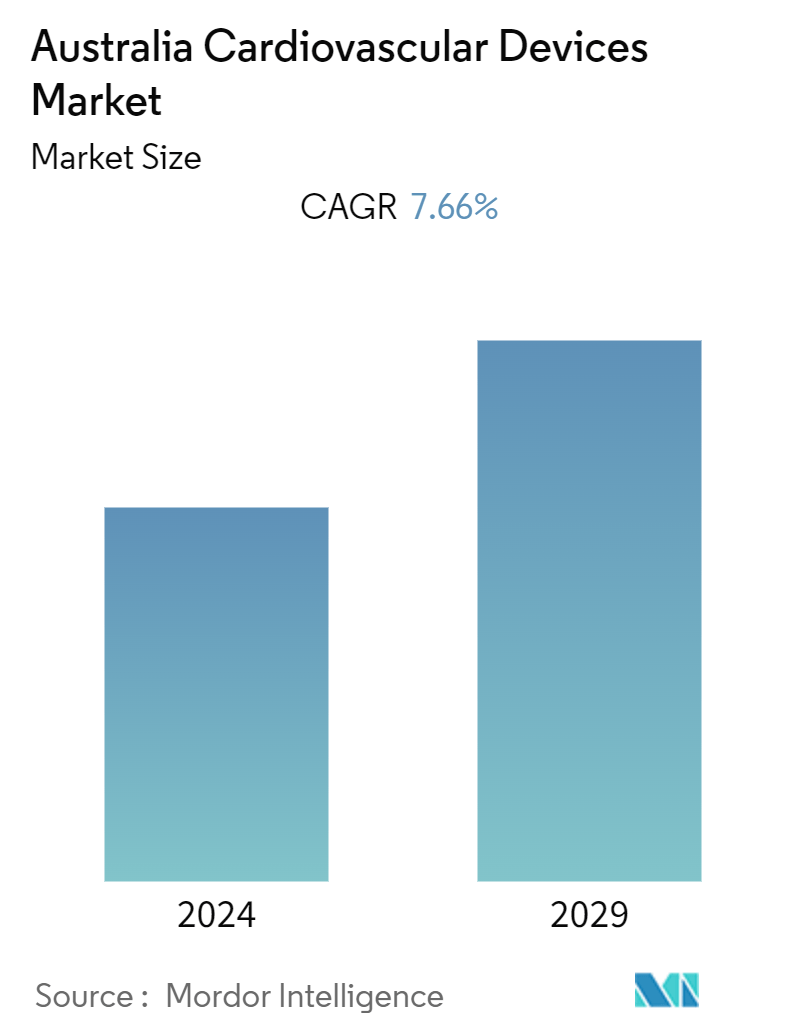Market Size of Australia Cardiovascular Devices Industry

| Study Period | 2019 - 2029 |
| Base Year For Estimation | 2023 |
| Forecast Data Period | 2024 - 2029 |
| Historical Data Period | 2019 - 2022 |
| CAGR (2024 - 2029) | 7.66 % |
| Market Concentration | Low |
Major Players
*Disclaimer: Major Players sorted in no particular order |
Australia Cardiovascular Devices Market Analysis
The Australia Cardiovascular Devices Market is expected to register a CAGR of 7.66% during the forecast period.
- The major factors driving the market are rapid technological advancements, the rising burden of various cardiovascular diseases, and increased preference for minimally invasive procedures. Heart-related mortality is caused by the rising prevalence of heart disorders such as cardiomyopathy and stroke. The most common diseases in the world are those related to the cardiovascular system.
- According to the June 2024 updates from the Australian Institutes of Health and Welfare report, in 2023, Australians lost an estimated 666,000 years of healthy life (DALY) due to all forms of cardiovascular diseases (CVD), equivalent to 25.1 per 1,000 population. In addition, the same source stated that 146,000 coronary angiography procedures were reported for patients admitted to the hospital – 97,200 (67%) for males and 48,900 (33%) for females. Thus, the high burden of cardiovascular diseases is expected to contribute to market growth over the forecast period.
- Heart disease increases with age, which of all ages is expected to drive the demand for cardiovascular devices for the diagnosis and management of these diseases, thereby augmenting market growth. For instance, according to October 2023 data from the University of Sydney, by 2026, more than 22% of Australians will be aged over 65 years. Thus, the growing aging population in the country, which is prone to cardiovascular diseases, is expected to contribute to market growth over the forecast period.
- Moreover, government support, increasing product approvals, and research and development activities undertaken by key market players contribute to the market's growth. For instance, in March 2022, the Regional Ministerial Budget Statement 2022-23 indicated that the Australian government allocated USD 17.2 million over four years to operate five mobile health clinics that will provide consultations and diagnosis in various medical specialties, including cardiology in Queensland.
- Therefore, owing to the rising prevalence of cardiac diseases and technological advancements in cardiovascular diseases, the market studied is expected to witness growth during the forecast period. However, stringent regulatory policies and product recalls are potential impediments to market growth.
Australia Cardiovascular Devices Industry Segmentation
As per the scope of the report, cardiovascular devices are used to diagnose and treat heart disease and related cardiovascular problems. Cardiac devices offer monitoring services to hospitals and physicians to take care of the patients with the help of the data collected by cardiac monitors.
The Australian cardiovascular devices market is segmented by device type. By type, the market is segmented as diagnostic and monitoring devices and therapeutic and surgical devices.
The report offers the value (USD) for the above segments.
| By Device Type | |||||||||
| |||||||||
|
Australia Cardiovascular Devices Market Size Summary
The Australian cardiovascular devices market is poised for growth, driven by the increasing prevalence of cardiovascular diseases and advancements in medical technology. Despite the initial adverse impact of COVID-19, which led to the postponement of elective cardiovascular procedures, the market has shown resilience and is expected to regain its pre-pandemic growth trajectory. The rising incidence of heart diseases, coupled with a growing preference for minimally invasive procedures, is fueling demand for cardiovascular devices. Technological innovations and product approvals are further propelling market expansion, with key players actively engaging in research and development to enhance their offerings. The market's growth is also supported by government initiatives and funding aimed at advancing clinical trials and improving cardiovascular care across the country.
Within the market, the electrocardiogram (ECG) and catheter segments are anticipated to experience significant growth. The ECG segment is benefiting from the increasing incidence of cardiac complications and the surge in product launches, including advancements in personal devices like smartwatches. Meanwhile, the catheter segment is gaining traction due to government support for cardiovascular services and technological advancements in cardiac catheters. Collaborative initiatives and new product approvals are expected to drive further growth in these segments. The competitive landscape is characterized by the presence of both international and local companies, with major players like Abbott Laboratories, Boston Scientific Corporation, and Medtronic PLC holding substantial market shares. Overall, the Australian cardiovascular devices market is set to expand, supported by technological advancements, increasing disease prevalence, and strategic industry collaborations.
Australia Cardiovascular Devices Market Size - Table of Contents
-
1. MARKET DYNAMICS
-
1.1 Market Overview
-
1.2 Market Drivers
-
1.2.1 Increasing Burden of Cardiovascular Diseases
-
1.2.2 Increased Preference for Minimally Invasive Procedures and Technological Advancements in Cardiovascular Devices
-
-
1.3 Market Restraints
-
1.3.1 Stringent Regulatory Policies and Product Recalls
-
-
1.4 Porter's Five Forces Analysis
-
1.4.1 Threat of New Entrants
-
1.4.2 Bargaining Power of Buyers/Consumers
-
1.4.3 Bargaining Power of Suppliers
-
1.4.4 Threat of Substitute Products
-
1.4.5 Intensity of Competitive Rivalry
-
-
-
2. MARKET SEGMENTATION (Market Size by Value - USD)
-
2.1 By Device Type
-
2.1.1 Diagnostic and Monitoring Devices
-
2.1.1.1 Electrocardiogram (ECG)
-
2.1.1.2 Remote Cardiac Monitoring
-
2.1.1.3 Other Diagnostic and Monitoring Devices
-
-
2.1.2 Therapeutic and Surgical Devices
-
2.1.2.1 Cardiac Assist Devices
-
2.1.2.2 Cardiac Rhythm Management Devices
-
2.1.2.3 Catheters
-
2.1.2.4 Grafts
-
2.1.2.5 Heart Valves
-
2.1.2.6 Stents
-
2.1.2.7 Other Therapeutic and Surgical Devices
-
-
-
Australia Cardiovascular Devices Market Size FAQs
What is the current Australia Cardiovascular Devices Market size?
The Australia Cardiovascular Devices Market is projected to register a CAGR of 7.66% during the forecast period (2024-2029)
Who are the key players in Australia Cardiovascular Devices Market?
Abbott Laboratories, Boston Scientific Corporation, Medtronic PLC, B. Braun SE and Cardinal Health Inc. are the major companies operating in the Australia Cardiovascular Devices Market.

